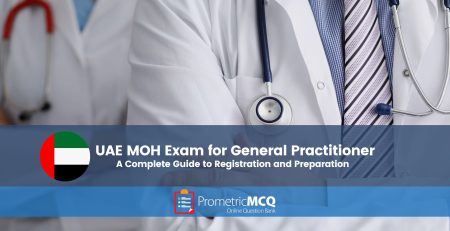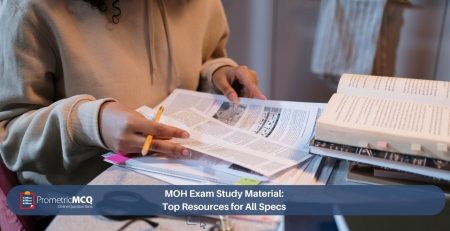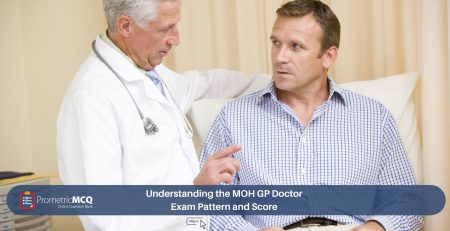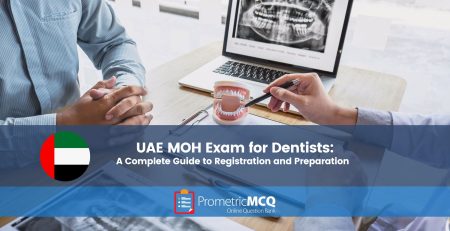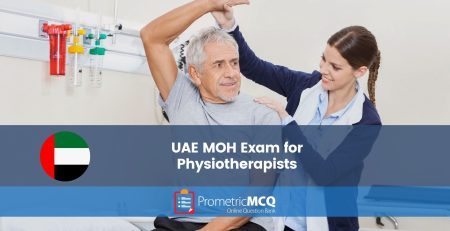
MOH Exam for General Surgeons: Preparation Strategy
fatima@prometricmcq.com2025-09-30T00:41:15+00:00Table of Contents
ToggleMOH Exam for General Surgeons: Preparation Strategy (2025)
The United Arab Emirates, with its world-class healthcare infrastructure and vision for medical excellence, is a highly sought-after destination for specialist surgeons globally. The Ministry of Health and Prevention (MOHAP) governs the licensing of medical professionals in the Northern Emirates, upholding a rigorous standard of care. For a General Surgeon, the gateway to practicing in this dynamic environment is the MOH Prometric Exam. This is not merely a test of surgical knowledge; it is a sophisticated evaluation of a surgeon’s clinical judgment, decision-making under pressure, and mastery of evidence-based surgical practice.
Success on the MOH General Surgery exam requires a strategic approach that goes far beyond reviewing textbooks. The exam is composed entirely of case-based Multiple-Choice Questions (MCQs) designed to simulate the complex scenarios encountered in the emergency room, the operating theater, and the post-operative ward. You will be tested on your ability to make an accurate diagnosis, formulate a sound management plan, and recognize life-threatening complications. The most effective preparation method, therefore, is one that centers on active learning through high-quality, exam-style MCQs.
This ultimate 2025 guide provides a definitive preparation strategy for the MOH General Surgery exam. We will dissect the exam’s pattern, provide a deep dive into the high-yield syllabus topics, present challenging sample questions with detailed, guideline-based rationales, and conclude with a comprehensive 10-point FAQ section. This guide is your strategic blueprint to transform months of hard work into a confident, successful exam performance.
Key Takeaways for the MOH Surgery Exam
- Master the Acute Abdomen: A significant portion of the exam revolves around the diagnosis and management of acute abdominal conditions.
- ATLS is Non-Negotiable: A thorough, practical understanding of the Advanced Trauma Life Support (ATLS) principles is absolutely essential.
- Pre-op & Post-op Care is High-Yield: Be prepared for numerous questions on patient optimization, fluid management, and the diagnosis of post-operative complications.
- Guideline-Based Answers: Your knowledge must align with the latest international guidelines from major surgical societies.
- Specialty-Specific MCQs are Crucial: Your preparation must be built around a question bank specifically designed for a general surgery board-level exam.
Deconstructing the MOH General Surgery Exam: Pattern and Syllabus
A successful strategy is built on a clear understanding of the exam’s framework. Knowing the structure is a vital part of your overall MOH Prometric exam preparation.
Core Exam Framework
- Administrator: Prometric
- Format: Computer-Based Test (CBT) with 100% MCQs.
- Structure: Typically 150 MCQs for a Specialist General Surgeon.
- Duration: Usually 3 hours (180 minutes).
- Scoring: A Pass/Fail result is provided. The unofficial passing score for specialist exams is estimated to be in the 65-70% range. There is no negative marking.
High-Yield General Surgery Syllabus Breakdown
The MOH exam covers the full breadth of general surgery. A focused study plan will prioritize the most heavily weighted domains.
| Surgical Domain | High-Yield Topics and Key Concepts for 2025 |
|---|---|
| Principles of Surgery & Critical Care (~25-30%) | This is the foundation. Trauma: ATLS principles (primary/secondary survey), management of shock, specific injuries (head, chest, abdominal). Pre-operative Care: Patient assessment, risk stratification (ASA score), nutritional support. Post-operative Care: Fluid and electrolyte management, wound healing and infections (SSI), DVT prophylaxis, management of complications (fever, ileus, anastomotic leak). Critical Care: Sepsis, ARDS, acid-base disorders. |
| Upper GI & Hepatobiliary Surgery (~20-25%) | Esophagus/Stomach: GERD, PUD and its complications (bleeding, perforation), gastric cancer. Hepatobiliary: Cholelithiasis, acute cholecystitis, choledocholithiasis, cholangitis (Charcot’s triad, Reynold’s pentad), pancreatitis (Ranson’s/Glasgow criteria), liver abscesses. |
| Colorectal & Acute Abdomen (~20-25%) | This is a massive, high-yield area. Acute Abdomen: Diagnosis and management of appendicitis, diverticulitis, small and large bowel obstruction, and mesenteric ischemia. Colorectal Disease: Colorectal cancer, inflammatory bowel disease (Crohn’s vs. UC), and benign anorectal conditions (hemorrhoids, fissures, fistulas). |
| Endocrine, Breast & Soft Tissue Surgery (~15-20%) | Breast: Benign vs. malignant breast disease, the triple assessment, management of breast cancer (lumpectomy, mastectomy, axillary staging). Endocrine: Thyroid nodules and cancer, primary hyperparathyroidism. Hernias: Inguinal, femoral, umbilical, and incisional hernias (anatomy and repair principles). Skin and soft tissue tumors. |
| Surgical Subspecialties Basics (~5-10%) | As a general surgeon, you are expected to know the basics of other areas. Vascular: Peripheral arterial disease, abdominal aortic aneurysm (AAA). Pediatric Surgery: Pyloric stenosis, intussusception. Urology: Testicular torsion, renal colic. |
Free MOH General Surgery Exam: Sample MCQs and Rationales
The following questions are designed to simulate the advanced clinical reasoning tested on the MOH exam. Analyze each case and its detailed rationale to master the application of surgical principles. For a comprehensive preparation, a dedicated QBank of MOH General Surgery MCQs is your most critical tool.
Question 1: Trauma & Critical Care
A 30-year-old male is brought to the emergency department after a high-speed motor vehicle collision. His initial vital signs are: BP 80/40 mmHg, HR 130 bpm, RR 28/min. He is drowsy. During the primary survey, you note decreased breath sounds on the left side of his chest, tracheal deviation to the right, and distended neck veins. What is the most appropriate immediate next step in management?
- Obtain an urgent chest X-ray.
- Insert a large-bore IV and begin fluid resuscitation.
- Perform needle decompression of the left chest.
- Prepare for endotracheal intubation.
Correct Answer: C (Perform needle decompression of the left chest.)
Rationale: This is a classic ATLS scenario. The patient is in shock and respiratory distress. The triad of decreased breath sounds, tracheal deviation away from the affected side, and distended neck veins is the textbook clinical diagnosis of a tension pneumothorax. This is a life-threatening emergency that causes obstructive shock by compressing the heart and great vessels. It is a clinical diagnosis that requires immediate intervention without waiting for radiographic confirmation. The correct, life-saving step is immediate needle decompression in the second intercostal space, midclavicular line, followed by formal chest tube insertion.
Why other options are incorrect:
A: Waiting for a chest X-ray will delay life-saving treatment and can lead to cardiac arrest. The diagnosis is clinical.
B: While fluid resuscitation is necessary for hemorrhagic shock, this patient is in obstructive shock. Giving fluids without relieving the obstruction will be ineffective.
D: While the patient may eventually require intubation, relieving the tension pneumothorax is the most immediate priority as it may restore adequate circulation and ventilation, potentially averting the need for intubation.
Question 2: Acute Abdomen
A 75-year-old female with a history of atrial fibrillation presents with a 12-hour history of severe, diffuse abdominal pain that is strikingly out of proportion to the physical exam findings. Her abdomen is soft with only mild tenderness, but she appears to be in extreme distress. Her lactate level is elevated. What is the most likely diagnosis?
- Acute pancreatitis
- Perforated peptic ulcer
- Acute mesenteric ischemia
- Small bowel obstruction
Correct Answer: C (Acute mesenteric ischemia)
Rationale: The hallmark feature of acute mesenteric ischemia (AMI) is “pain out of proportion to physical exam findings.” This classic description, especially in an elderly patient with a risk factor for emboli (atrial fibrillation), is highly suggestive of an embolic occlusion of the superior mesenteric artery. The severe visceral pain from bowel ischemia precedes the development of peritonitis (guarding, rigidity). An elevated lactate level is a late but highly specific sign of bowel infarction. AMI is a surgical emergency with a very high mortality rate if not diagnosed and treated promptly.
Why other options are incorrect:
A & B: Pancreatitis and a perforated ulcer would typically present with significant abdominal tenderness, guarding, and/or rigidity on examination.
D: Small bowel obstruction usually presents with colicky pain, vomiting, and abdominal distension, with physical findings that match the severity of the symptoms.
Frequently Asked Questions (FAQs) for the MOH General Surgery Exam
The exam is graded on a Pass/Fail basis. The official passing score is not published by MOHAP. However, for a specialist examination, the unofficial passing threshold is generally considered to be in the range of 65% to 70%. A safe target is to consistently score above 75% in practice tests.
The MOH exam is a competency assessment for licensure, not a board certification. While the clinical content is based on the same international guidelines (e.g., from the American College of Surgeons), it is a purely multiple-choice exam. It does not have the clinical (OSCE) or oral (viva) components of exams like the MRCS/FRCS. The scope is focused on the knowledge expected of a safe, independent general surgeon.
No, the MOH exam is a clinical knowledge test based on international standards. It does not include questions about local administrative policies, public health statistics, or specific hospital protocols in the UAE.
While there are no pure basic science questions, a deep, clinically applied understanding of anatomy and physiology is essential to answer the case-based questions. For example, a question about managing a duodenal injury requires intimate knowledge of the duodenum’s blood supply and its relationship to the pancreas.
Primary Source Verification (PSV) by DataFlow is a mandatory verification of your credentials. For a surgeon, this is an exhaustive process that includes your medical degree, internship, general surgery residency/specialization certificates, and any subspecialty fellowships. A positive DataFlow report is required before MOHAP will issue your final UAE MOH license.
You are unlikely to be asked to identify a specific instrument by name. However, you are expected to understand the principles of which type of instrument or suture to use in a given situation (e.g., using an absorbable suture for a bowel anastomosis).
A combination of a major, up-to-date general surgery textbook (e.g., Sabiston or Schwartz) and, most importantly, a high-quality, board-level question bank is the ideal strategy. The QBank is essential for mastering the application of knowledge in an MCQ format.
MOHAP typically allows three attempts to pass the licensing exam. There is a required waiting period between attempts. A failure should be a signal to critically reassess your preparation strategy and focus more intensively on question-based active learning.
It is very important. Laparoscopic procedures are the standard of care for many conditions (e.g., cholecystectomy, appendectomy). You should be familiar with the principles, indications, contraindications, and potential complications of common laparoscopic surgeries.
The gold standard for trauma knowledge is the Advanced Trauma Life Support (ATLS) course from the American College of Surgeons. Your knowledge and decision-making should be based firmly on the ATLS principles and algorithms. This is one of the highest-yield topics on the entire exam.
Conclusion: Your Path to a Surgical Career in the UAE
The MOH General Surgery Exam is a rigorous and comprehensive assessment designed to ensure that surgeons practicing in the UAE are of the highest caliber. It is a challenge that demands a deep, evidence-based understanding of surgical principles and a disciplined, strategic approach to preparation. By focusing on the high-yield syllabus domains, mastering the principles of trauma and critical care, and committing to a rigorous practice schedule with high-quality MCQs, you can approach the exam with the confidence of an expert. Passing this exam is the definitive step toward a successful and rewarding surgical career in the UAE.
Ready to Master Surgical Principles and Ace Your Exam?
Our premier General Surgery question bank is filled with high-yield clinical scenarios, detailed, guideline-based rationales, and full-length simulated exams designed to cover the entire MOH syllabus and ensure your success.


